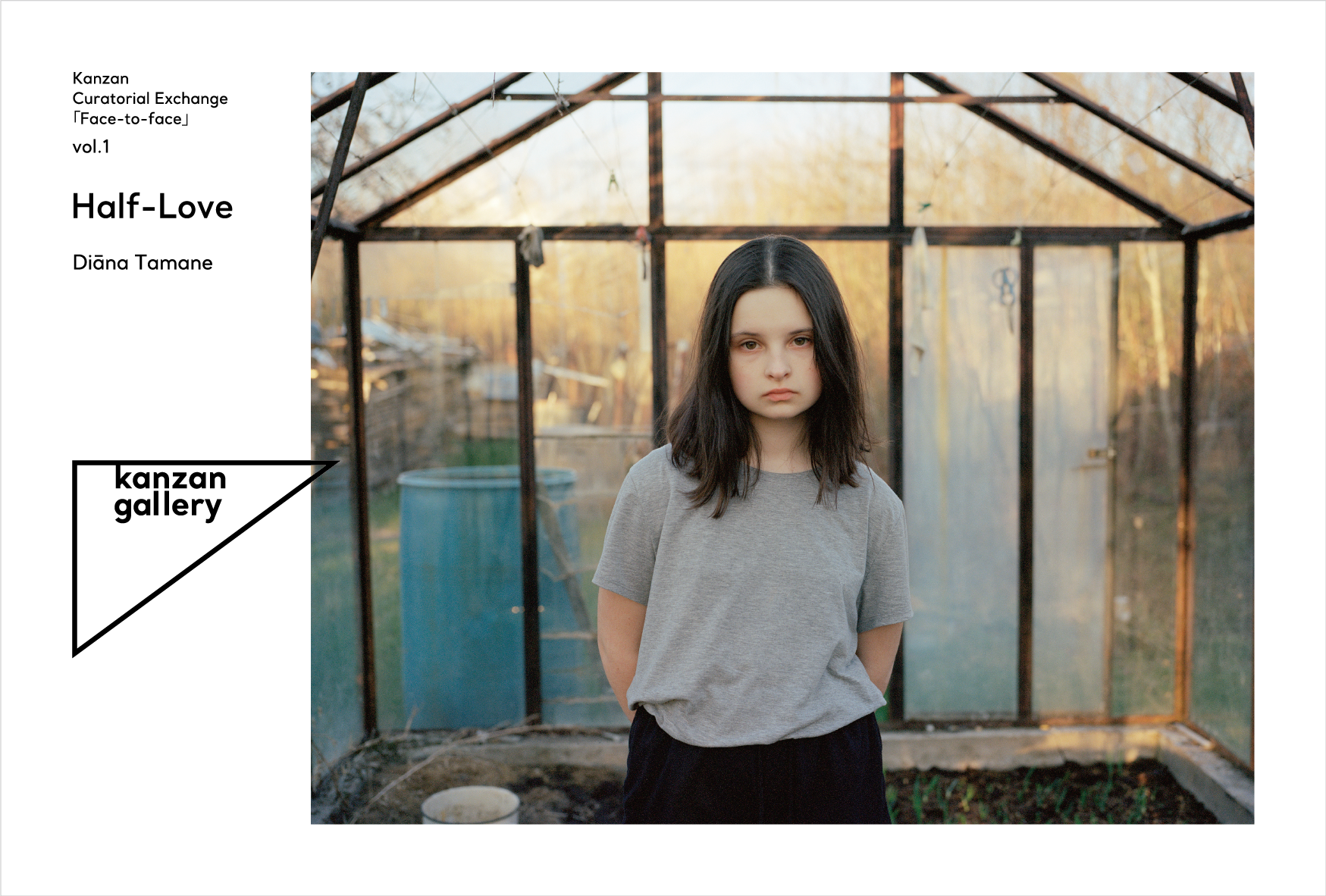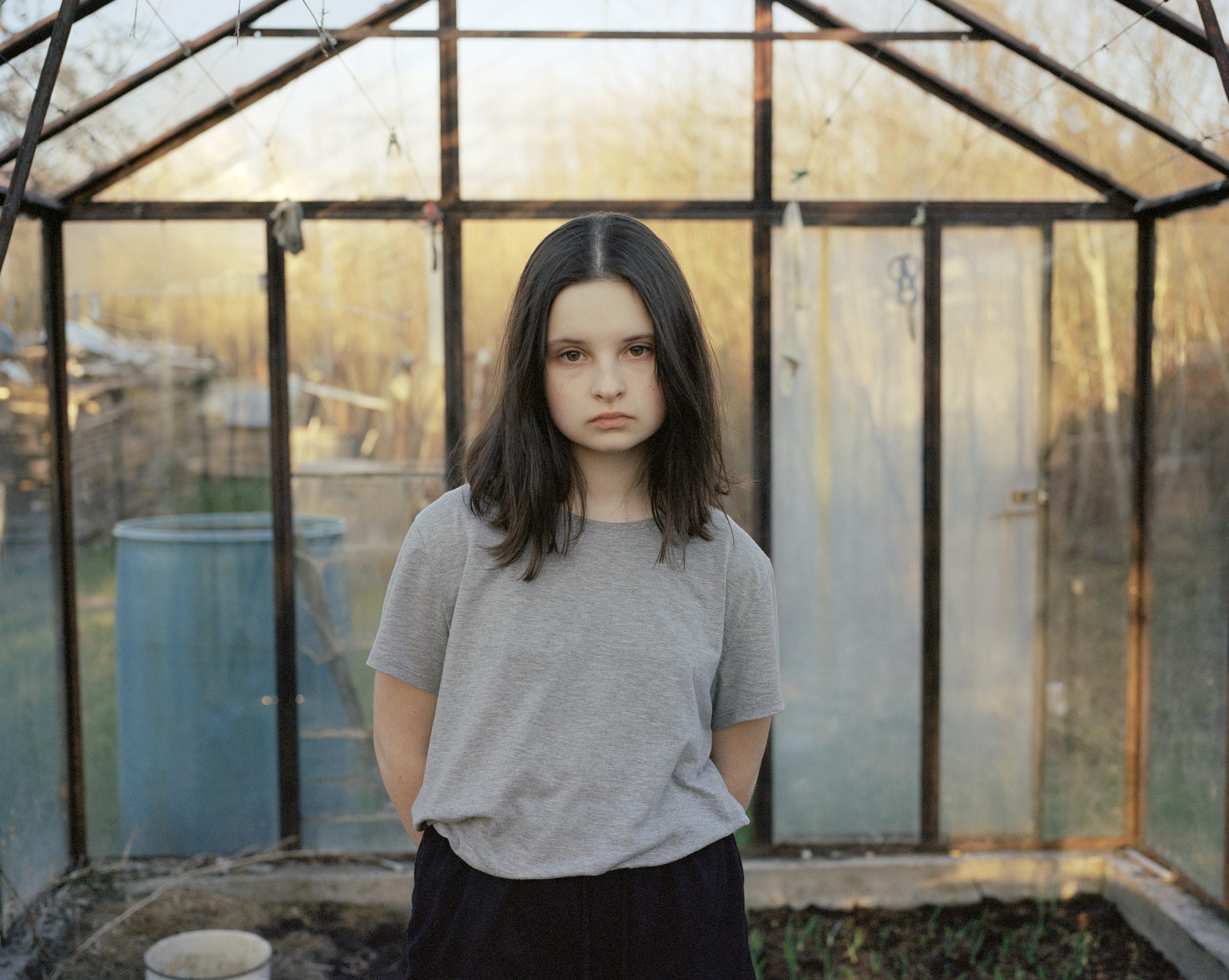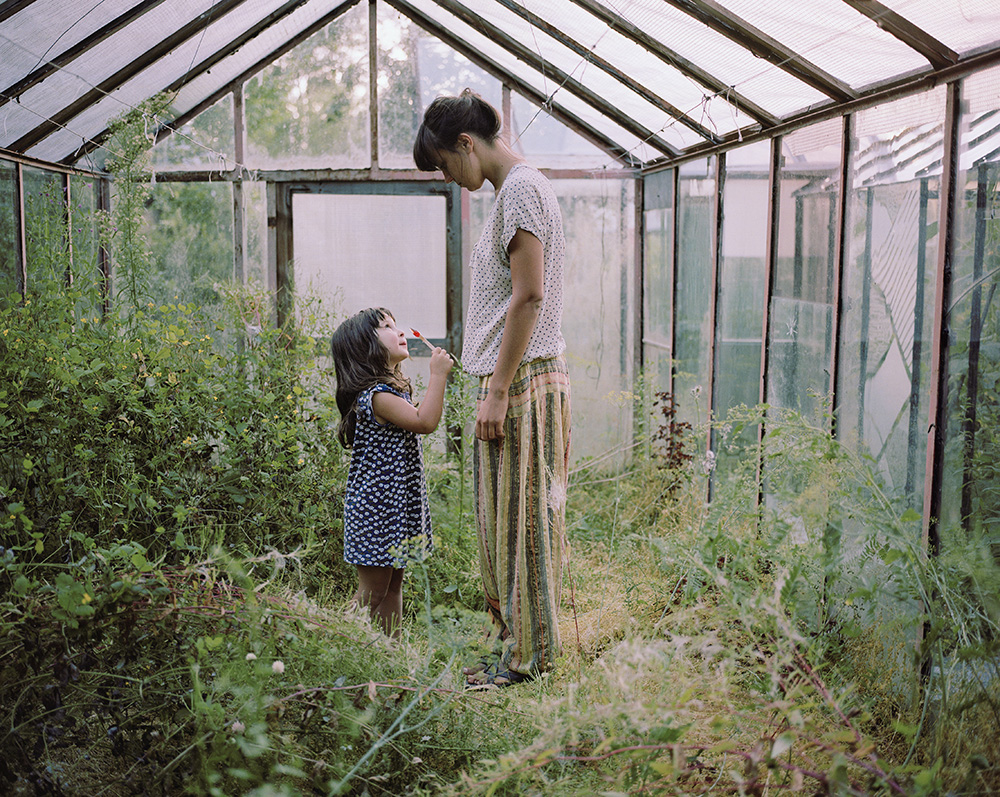Exhibitions

kanzan Curatorial Exchange 「Face-to-face」vol.1
Half-Love|Diāna Tamane
2024.2.16 Fri - 3.31. Sun
キュレーター/Curator : 小池浩央 Hirohisa Koike
GALLERY TALK|2月16日[金]6PM-|予約不要/入場無料
Diāna Tamane(アーティスト) × 小池浩央(写真家・写真研究者)
Fri, Feb. 16, 6PM - @kanzangallery (no reservation required / Admission Free)
Featuring Diāna Tamane (Artist) in conversation with Hirohisa Koike (Photographer & Photography Researcher)
フランスの哲学者ジャック・デリダは、同じくフランスの精神分析家エリザベート・ルディネスコとの対談において、「父と母が、または、父あるいは母が、真正の「親」であると実際に信じた瞬間から、すなわち、彼らのところにあると信じるものの「親」であると信じた瞬間から、幻想が運動し始め、またなんらかの運動を引き起こすのです」1と述べている。デリダによれば、自分の血が流れているから他人の子供よりも自分の子供を愛するという遺伝的なるものもまた幻想にすぎない。なぜならば養子にした子供に対しても、あるいは新生児のときに産科病院で取り違えられたことを知らずに育てられた子供に対しても同じかあるいは似たようなナルシシズム的同一性を投影することになるからである。一般的に、自分が産まれた瞬間の記憶を持つことはなく、あくまで事後的に「この」母から産まれたのだということを聞かされ、それを信じたときに彼女は母に「なる」のである。家族は決して自然的なもの、あるいは永遠的なものではなく、その絆もまたつかの間のものでしかないからこそ、日々あらたに作り出されるべきものとして示されるのである。
タマネの初めての個展「From my family album I」(2012年)は父、母、義父、曾祖母、そして自身などをそれぞれ撮影したポートレートで構成されている。それ以来彼女は一貫して家族をテーマに制作を続けてきた。2013年から続けられているシリーズ「Family Portrait」は、彼女がリガに戻るたびに、母、祖母、曾祖母と一緒にソファに座り、数分間カメラを見つめる様を撮影した、いわば女系のセルフポートレートである。そして「Topology of Touch」(2015年)では母、祖母、曾祖母と自身の皮膚を写した写真を用い、「Flower Smuggler」(2017年)では祖母が祖父の墓に供えるために植木鉢を持って国境を越えた際、密輸入の容疑で告発されたというエピソードをもとに制作された。ここで見られるのは、常にタマネが「私はどこからやって来たのか」という家族の系譜の歴史性に意識を向けていたことである。
ところが今回の「Half-Love」では、タマネの興味は2008年に生まれた異母妹エリーナに向けられる。この作品に含まれる、タマネから異母妹に宛てられた手紙の中で、「いつまであなたの写真を撮るつもりかと聞かれましたね。あなたが18歳になるまで、あるいは私が生きている限りと答えました。いいかな、と私は尋ね、いいよ、とあなたは言いました」と書いている。これまでのタマネの作品においては(決して意図しているわけではないものの)家族の誰かが亡くなることで終わりをむかえることがあった(例えば「Family Portrait」では2016年に曾祖母が亡くなり、それまで4人で映っていたのが3人になっている)。そうでなくともより早く生まれた者が先に亡くなる可能性を想像することは難くない。しかし、今回の作品においては、異母妹に宛てた手紙の中で、タマネが先に亡くなるだろうことを示唆している。この過去から現在に向かって辿ってきた歴史を、現在から未来へと開いていこうとする時間の捉え方の変化にこそ、この「Half-Love」の本質がある。
写真を撮られる際に顔がこわばったり、姿勢がぎこちなくなったりする、あの独特の居心地の悪さは、他者たちが思う自分、私がそう思ってきた自分であるような、自分の姿を想像してそれに合わせることへの違和感である。なぜならば自分の本質は、いかなるイメージとも異なったところにあるからだ。しかし、ロラン・バルトはそのような「イメージの重圧を取り除いてくれるのは、愛、極度の愛」2なのだと述べている。そして愛とは、エマニュエル・レヴィナスが言い換えるように、「他者の運命をみずからの責任において引き受けること」であり、「それこそが〈顔〉を「見ること」4 なのである。エリーナの「いいよ」3という答え、そして写真の中で彼女がディアーナを見つめ返す視線は、これまでの時間のなかでつむがれた、二人の間の「極度の愛」を示しているのではないだろうか。
小池浩央
——————————
1 ジャック・デリダ、エリザベート・ルディネスコ『来たるべき世界のために』、藤本一勇、金澤忠信訳、岩波書店、2003年、65頁。
2 ロラン・バルト『明るい部屋』、花輪光訳、みすず書房、1985年、21頁。
3 エマニュエル・レヴィナス『われわれのあいだで 《他者に向けて思考すること》をめぐる試論』、合田正人、谷口博史訳、法政大学出版局、1993年、146頁。
4 同書、146頁。
–
In a conversation with Élisabeth Roudinesco, Jacques Derrida stated: “it gives movement from the moment the father and/or mother actually believe they are the authentic ‘parent’ of what is thus growing in them. 1” According to him, the genetic reason for loving one’s children more than the children of others is also only a fantasy. This is because we will project the same or similar narcissistic identification onto the child we have adopted or onto the child we have brought up, unaware that they were mistaken in the maternity hospital when they were a newborn. Generally, we do not remember the moment of our birth but are told only after the fact that we were born of ‘this’ mother, and she ‘becomes’ a mother when we believe it. Thus, the family is never natural or eternal, and its bonds are only fleeting, which is why it is presented as something to be created anew day by day.
Diāna Tamane’s first solo exhibition, From My Family Album I (2012), consisted of portraits of her father, mother, step-father, great-grandmother, and herself. Since then, she has consistently worked on the theme of family, and since 2013, she has continued the series Family Portrait, a self-portrait of her maternal line in which she sits on the sofa with her mother, grandmother and great-grandmother and stares into the camera for a few minutes. Then, in Topology of Touch (2015), she used photographs of the skin of her mother, grandmother, great-grandmother and her own, and in Flower Smuggler (2017), based on an episode in which her grandmother was accused of smuggling when she crossed the border with a flowerpot to make an offering at her grandfather’s grave which is in current Russia. What can be seen here is that Tamane was always conscious of the historicity of her family genealogy: ‘Where did I come from?’
However, in the current series of Half-Love (2022), Tamane’s interest turns to her half-sister Elīna, born in 2008. In a letter from Tamane to her half-sister, included in the work, she writes: “You also asked how long I am going to take pictures of you. I said until you are eighteen or perhaps as long as I live. May I, I asked. Yes, you said.” Previous works by Tamane have sometimes (although never intentionally) ended with the death of a family member (e.g. in Family Portrait, the great-grandmother died in 2016, and the four people previously shown in the video were now three). Otherwise, it is not difficult to imagine the possibility that those born earlier might die first. However, in the present work, Tamane suggests in a letter to her half-sister that Tamane will probably die first. This change in the way of perceiving time, which attempts to open up the history that has been traced from the past to the present into the future, is the essence of Half-Love.
That peculiar, uncomfortable feeling of stiffening of the face and awkwardness of posture when being photographed is the discomfort of imagining and conforming to what others think we are, what we have always felt we are. This is because our essence is different from any image of ourselves. However, as Roland Barthes states: “For it is not indifference which erases the weight of the image (…) but love, extreme love”. 2 And love is, as Emmanuel Levinas put it, “the taking upon oneself of the fate of the other 3,” and “That is the ‘vision’ of the Face 4“. Elīna’s answer, “Yes”, and how she looks back at Diāna in the photograph indicates the existence of extreme love between them that has been nurtured over time.
Hirohisa Koike
——————————
1 Derrida, Jacques, Élisabeth Roudinesco, De quoi demain… : Dialogue, Librairie Arthèe Fayard et Galilée, 2001, p. 79 (trans. author).
2 Barthes, Roland, Camera Lucida: Reflections on Photography, translated by Richard Howard, Hill and Wang, 1981, p. 12.
3 Levinas, Emmanuel, Entre nous: on thinking-of-the-other, translated by Michel B. Smith and Barbara Harshav, Columbia University Press, 1998, p. 103.
4 ibid., p. 103
Profile
ディアーナ・タマネ(ラトビア/エストニア)
1986年リガ生まれ、タルトゥ在住。主な表現媒体は写真だが、作品の中でビデオ、テキスト、ドローイングも用いる。彼女の作品は、家族のアルバムや文書、個人的な手紙が触媒となり、感動的な自伝的物語だけでなく、社会や近現代史についての的確な描写を可能にしている。
タルトゥ芸術大学写真学科卒業(学士)、LUCA芸術学校ブリュッセル校修了(修士)。ゲントのHISKのポスト・アカデミック・プログラムでアーティスト・イン・レジデンスを経験。
2020年、ベルギーのAPE(Art Paper Editions)から初の写真集『Flower Smuggler』を出版。同年のレ・ランコントル・ダルルブックアワードで著作賞を受賞し、パリ・フォト・アパーチャー財団フォトブックアワードの最終候補に選ばれた。
タマネはキエフ・ビエンナーレ(2021年)、アートフェスティバル「サバイバル・キット10.1」(リガ、2019年)、第1回リガ国際現代美術ビエンナーレ(2018年)、カトマンズ・トリエンナーレ(2017年)に参加している。作品はラトビア国立美術館、ヴィンタートゥール写真美術館(スイス)、タルトゥ美術館(エストニア)に収蔵されている。またタマネは、エストニアのアーティスト給与2024-2026の受賞者のひとりである。
Diāna Tamane
(Latvia / Estonia, 1986) was born in Riga, lives and works in Tartu. Her primary medium of expression is photography, but she also uses video, text and drawings in her work. In the artist’s works, family albums, documents and private correspondence are transformed into catalysts, making it possible to reveal not only touching autobiographical stories but also apt portrayals of society and recent history.
Tamane graduated in photography from the Tartu Art College (BA) and the LUCA School of Art in Brussels (MA). She has been an artist-in-residence at the post-academic program in HISK in Ghent.
In 2020, APE (Art Paper Editions) published her first book, Flower Smuggler, which received the Authors Book Award at Les Rencontres d’Arles Book Awards 2020 and was shortlisted for the Paris-Photo Aperture Foundation PhotoBook Awards.
Tamane has participated in the Kyiv Biennial (2021), the art festival Survival Kit 10.1 (2019), the 1st Riga International Biennial of Contemporary Art (2018) and the Kathmandu Triennial (2017). Her works are held in the collections of the Latvian National Museum of Art, Fotomuseum Winterthur (Switzerland) and Tartu Art Museum (Estonia). Tamane is one of the laureates in Estonia for the artist’s salary 2024–2026.
小池浩央
武蔵野美術大学大学院映像研究科修了後、フランス・ナント美術大学にてアーティスト・リサーチャー、エストニア芸術大学にて講師。現在はエストニア・タリン大学大学院博士課程在籍中。専門は写真論・フランス現代思想。研究テーマは、ジャック・デリダの概念的遺産に基づく写真における遅延・喪・贈与についての考察。主な論文に「Lein ja fotograafia: Jacques Derrida fototeooria」(Etüüde nüüdiskultuurist; 9, 2021)、「The noeme of photography: the paradigmatic shift in the photographic theory of Roland Barthes」(Kunstiteaduslikke Uurimusi / Studies on art and architecture, 28 (3-4), 7-26., 2019)。
Hirohisa Koike
After completing his postgraduate studies in Imaging Arts and Sciences at Musashino Art University, Hirohisa Koike furthered his career in France as an artist-researcher at the École des Beaux-Arts de Nantes and as a lecturer at the Estonian Academy of Arts. He is currently a Ph.D. candidate at Tallinn University, Estonia. His expertise lies in photographic theory and contemporary French thought. His research focuses on the contemplation of delay, mourning, and the gift in photography, based on the conceptual legacy of Jacques Derrida. His notable publications include “Lein ja fotograafia: Jacques Derrida fototeooria” (Etüüde nüüdiskultuurist; 9, 2021) and “The noeme of photography: the paradigmatic shift in the photographic theory of Roland Barthes” (Kunstiteaduslikke Uurimusi / Studies on art and architecture, 28 (3-4), 7-26., 2019).







